
ADYNAMIC BONE: MECHANISMS IN THE ELDERLY END-STAGE RENAL DISEASE PATIENTS?
Víctor Lorenzo MD1, Marisa Martín, MD 2, Margarita Rufino MD 1, Alejandro Jiménez Ba Sci3, Alejandro Martin Malo MD 4, Emilio Sanchez MD 5, Domingo Hernández MD 1, Mariano Rodríguez MD 4, Armando Torres MD * 3
1 Nephrology Section. University Hospital of Canary Islands. Santa Cruz de Tenerife.
3 Research Unit. University Hospital of Canary Islands. Santa Cruz de Tenerife.
5 Hemodialysis Unit. Tamaragua Hospital. Santa Cruz de Tenerife.
2: Nephrology Section. University of Navarra (School of Medicine). Pamplona.
4 Nephrology Section and Research Unit, "Reina Sofia" University Hospital, Cordoba.
Spain
E-mail:lorenzovictor@terra.es
Acknowledgments: This study was supported by grant 98-0786 of the Spanish Ministry of Health (FIS).
| DISCUSSION BOARD |
DEFINITIONS
Before starting, I would like to define a number of terms that will be used repeatedly in this presentation.
Adynamic bone: It is a condition of low bone turn-over (defined by histomorphometric cuantification: low BFR, low cellularity and normal or reduced osteoid thickness.
Relative hypoparathyroidism: Means that the PTH levels although high as compared with normals, is insufficient to maintain normal bone turn-over
Elderly: There is no universally accepted age that is considered elderly among societies. Presently in most Western countries, 60 or 65 is the age of eligibility for retirement and old-age social programs and used in most articles to define the elderly.
Acronyms used in the text
ABD: Adynamic Bone Disease
PTH: Parathyroid Hormone
MHD: Maintenance Hemodialysis
ESRD: End-stage renal disease
Ca: Calcium
P: Phosphorus
MAGNITUDE OF THE PROBLEM
CLINICAL RELEVANCE
· Recently, some paper reported that the apparent better control of PTH values in the elderly should not be considered innocuous. Along with a higher incidence of ABD, lower PTH levels may be associated with an increased risk of fractures, soft tissue calcification and death.
· Thus, the magnitude of this problem justifies further efforts to know the mechanisms involved in its pathogenesis.
MECHANISM OF ABD IN THE ELDERLY
1.- A decreased Bone response to PTH
2.- The spontaneous decrease in Protein Intake observed in the elderly, leading to better control of serum P and lower levels of PTH.
Decreased Bone response to PTH
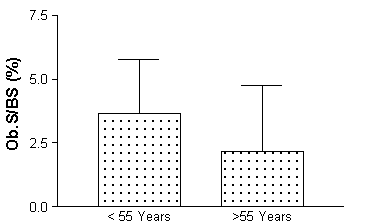

Spontaneous decrease in protein intake
Since the dietary intake of P is closely related to the intake of proteins, as we described in the next Figure, we hypothesize that the observed spontaneous decrease in protein intake in the elderly may favor a better control of serum P and PTH levels. If this is true, the high incidence of relative hypoparathyroidism and ABD among elderly HD patients may be attributed, at least in part, to changes in their nutritional habits.
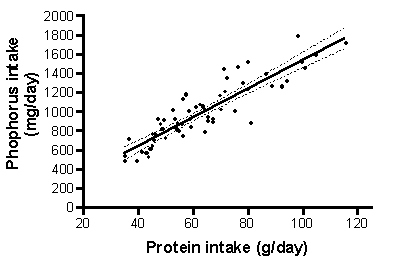
This data has been published in: Lorenzo V et al: Protein intake, control of serum phosphorus and relatively low levels of parathyroid hormone in elderly hemodialysis patients. Am J Kid Dis 37:1260-1266, 2001
We performed a cross sectional study including 207 patients on standard HD, from 6 spanish centers, Patients receiving CTR were not included. Dietary intake was recorded over 5 day-period in 95 patients.
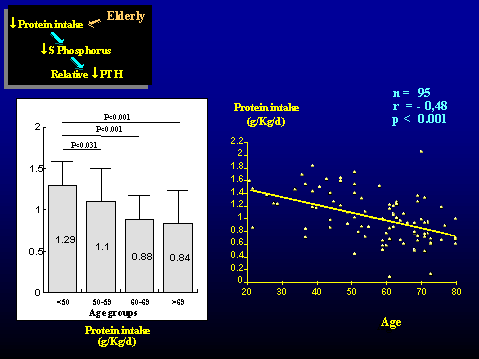
In a subsequent analysis, a significant positive correlation was found between serum P and protein intake. And also, between serum P and PTH.
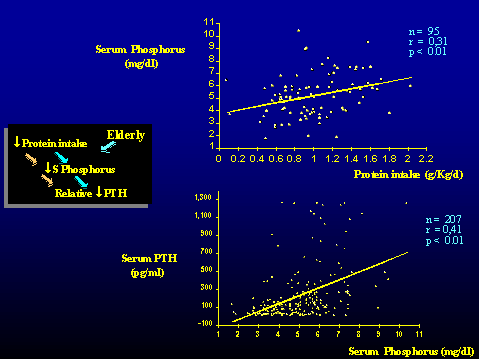
|
B Coeff. |
B St error |
b |
T |
Sig. |
|
|
Serum P |
104 |
21.6 |
0.45 |
4.87 |
< 0.001 |
|
Serum Ca |
106 |
41.0 |
0.24 |
2.59 |
= 0.011 |
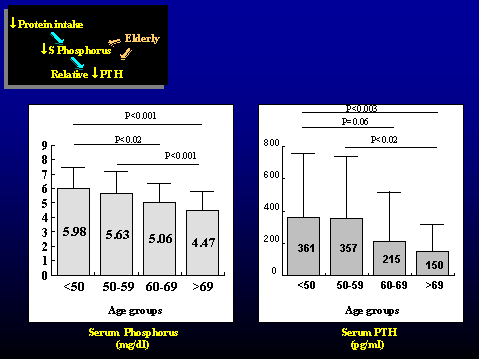
1.- An age-related decrease of osteoblast response to PTH favors the development of ABD in older MHD population.
2.- The spontaneous reduction in protein intake observed in older patients on MHD is associated with lower levels of serum P. The control of serum P is in part responsible for the relative low PTH levels and the higher incidence of ABD in elderly MHD patient.
These findings may help to clarify mechanisms by which adynamic bone is frequently observed in this patient population.
Correspondence to:
Dr. Victor Lorenzo
Division of Nephrology. University Hospital of Canary Islands.
Ofra. La Laguna.
38320 Santa Cruz de Tenerife. Canary Islands. Spain
E mail: lorenzovictor@terra.es